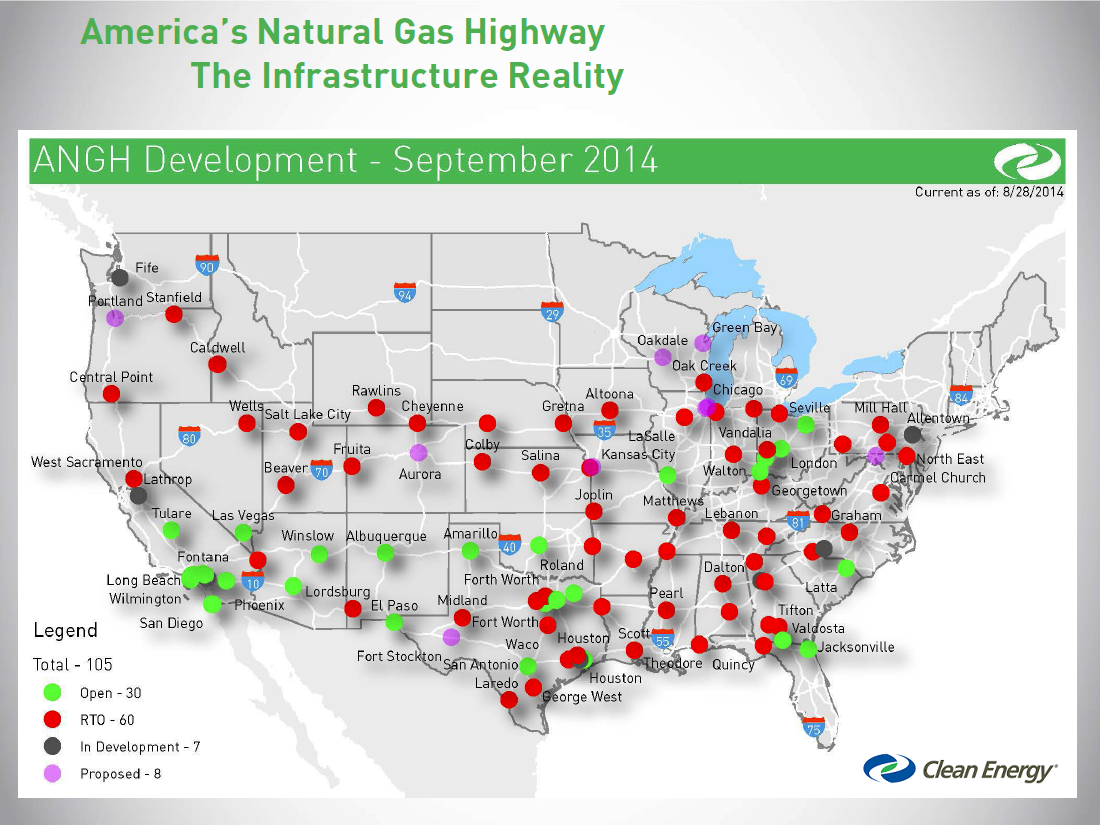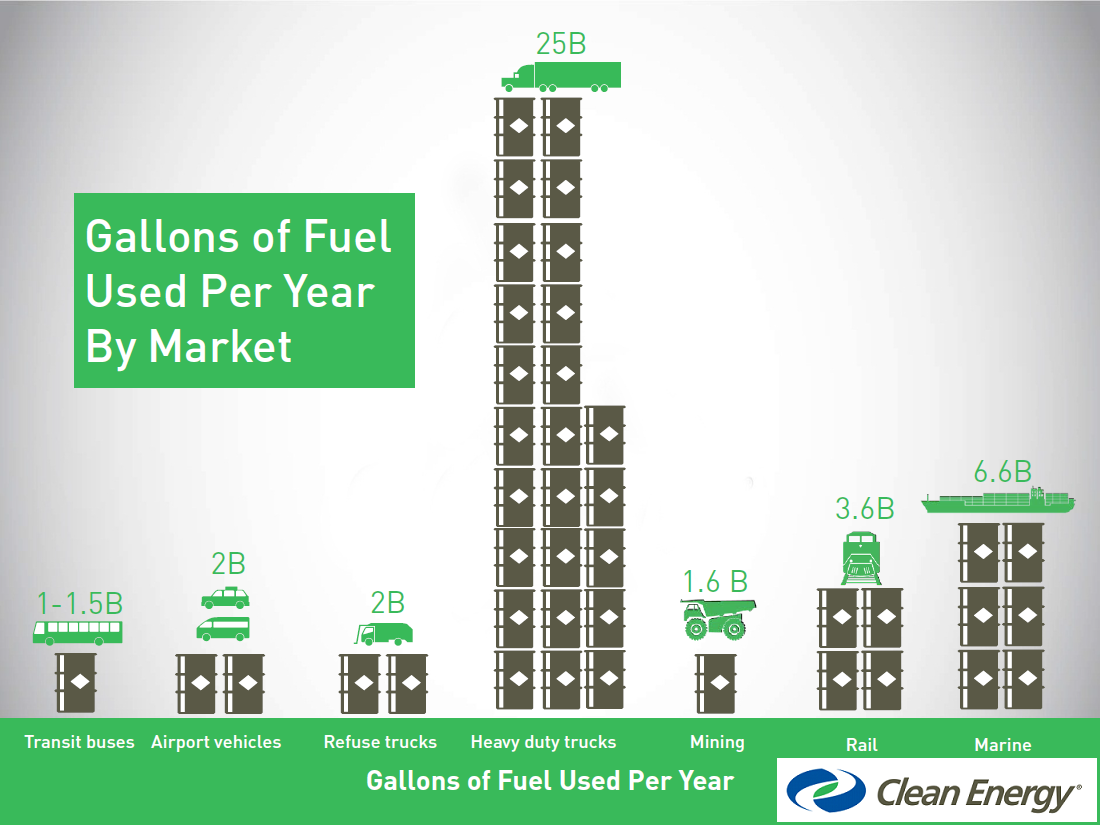Published at FC Gas Intelligence, Oct. 23, 2014
Clean Energy Fuels Corp (NASDAQ: CLNE) has made a series of announcements lately that highlight the company’s growth milestones.
Clean Energy is the largest provider of vehicular natural gas, CNG & LNG, in North America with a broad customer base in the refuse, transit, shuttle, taxi, interstate trucking, airport and municipal fleet markets with tens of thousands of vehicles fueling at strategic locations in the United States and Canada.
In October, 2014 Clean Energy reported that for the first time it delivered over 50 million compressed natural gas (CNG) gallons in one quarter. Clean Energy has been busy signing up fleet customers as well as opening up new fueling stations.
Recent examples include Giant/Martin’s grocery stores who are piloting a new LNG trucking program for their heavy duty fleet. To support this effort Clean Energy will open a new public fueling station in Carlisle, PA. Clean Harbors, Inc., who transport hazardous waste, will being deploying CNG and LNG trucks and projects to consume nearly 180,000 DGEs (diesel gallon equivalents) annually. Salt Lake County, Utah plans to fuel 25 new CNG refuse trucks and Clean Energy will operate and maintain a private filling station for the fleet.
Dillon Transport announced on October 7 that they signed a multi-year fueling agreement with Clean Energy. Dillon is a leader in the transportation industry in using natural gas. Clean Energy is scheduled to supply Dillon with approximately 2.5 million DGEs of CNG and LNG annually and will open three additional public fueling stations in Houston and Midland, TX and Atlanta, GA to accommodate the increased sales.
The town of Islip, NY, on Long Island, will enforce a new mandate requiring all refuse trucks servicing the town operate on CNG. Clean Energy will build and operate a new fueling station for the town serving over 200 refuse trucks. Islip is the fourth town on Long Island to mandate such clean air initiatives and joins Smithtown, Brookhaven, and Huntington where Clean Energy already operates three natural gas fueling stations.
In October, 2014 Clean Energy acquired a controlling interest in NG Advantage LLC, a pioneer in the natural gas “virtual pipeline” delivery system. The virtual pipeline allows commercial and industrial customers who are not connected to gas pipeline infrastructure to receive shipments of gas in CNG tanks delivered by truck. The target market are institutional users such as food processors, hospitals, manufacturers, and paper mills currently using fuel oil, coal or propane. Among NG Advantage assets is a compression station in Milton, VT capable of supplying nearly 16 million gasoline gallon equivalents (GGEs) annually, this station will be Clean Energy’s highest volume station.
Clean Energy has a new website, cleanenergyfuels.com, with an interactive map feature that allows users to quickly locate natural gas fueling stations near them. An accompanying iPhone app is scheduled to be released in November, 2014.
Clean Energy markets a brand of renewable natural gas (RNG) they call Redeem. Sales of Redeem represent 17% of the total volume of natural gas sold by Clean Energy. Most of the RNG sourced by Clean Energy comes from landfills and is used in refuse hauling trucks. This is a very attractive and practical process since the refuse trucks can simply refuel at the landfill when they dump their loads. Elsewhere, RNG is sourced from farms or food waste digesters and cleaned up to natural gas pipeline standards and injected into the pipeline system. According the California Air Resources Board, RNG enables a 90% reduction in carbon emissions when displacing diesel or gasoline. RNG is the only commercially available fuel that can be carbon negative.
Clean Energy’s stock has been under pressure in recent months as the company has invested heavily in building out its fueling station network, known as America’s Natural Gas Highway (ANGH). Clean Energy has built out over 100 ANGH stations but has only opened up 30 of them, leaving 70-plus stations ready to begin operations as soon as demand grows. Clean Energy intends to continue building out stations, albeit at a slightly slower pace than last year. Clean Energy has racked up more than $600 million in debt, but is clearly building for the future.
One challenge for Clean Energy is that they got out ahead of the engine market for tractor trailers. Cummins Westport was delayed for a year in releasing their heavy duty truck engine, the ISX12 G, it was finally available in September 2013 to good reviews and sales. The ISX12 G 12 liter engine is intended for tractor trailers and long distance trucking applications, and is the first natural gas engine aimed specifically at that market which consumes 25 billion gallons of fuel per year. The success of the ISX12 G is critical to Clean Energy’s plans as truckers are the market they are aiming for as well. Cummins Westport’s smaller engine, the ISL G 9 liter, has been a success for a few years in the transit bus and refuse hauling markets where it is an ideal fit, but that market is much smaller at 5-6 billion gallons per year.
For any fleet owner who is considering switching fuels it is assumed that they will save money on fuel, trucks and maintenance. There needs to be no impact on operations, meaning that they can continue to haul the same size payloads and refuel with convenience. Drivers need to be satisfied with the change as well, fortunately drivers have consistently reported being very happy with the natural gas trucks since they are noticeably quieter and the fuel is clean so they don’t go home smelling of diesel (which makes their spouses happy as well). Fleet owners have been able to use their use of natural gas as a selling point for their customers who may be impressed by their improved environmental impacts, advanced technology and quiet, clean operations.
Natural gas fuel costs up to $1.50 less per gallon than gasoline or diesel, depending on local market conditions, but these prices have been under pressure recently with the falling price for oil. The use of natural gas reduces greenhouse gas emissions up to 30% in light-duty vehicles and 23% in medium to heavy-duty vehicles. In addition, nearly all natural gas consumed in North America is produced domestically.

